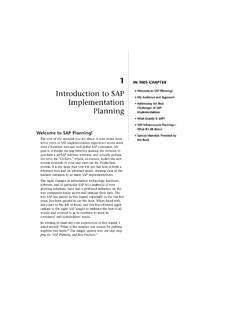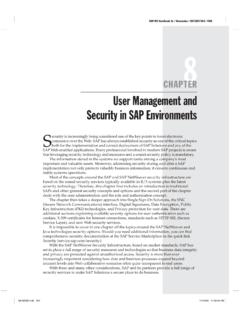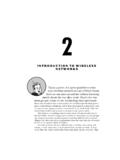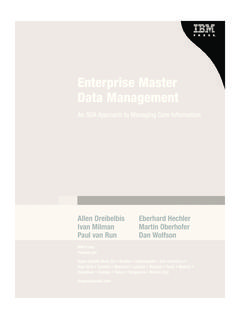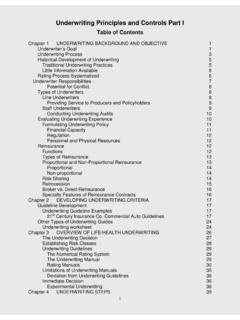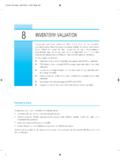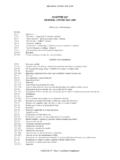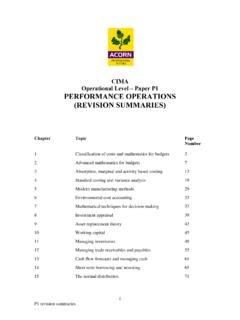Transcription of Organizing and Managing the Call Center - …
1 61 3 Organizing and Managing the call Center You don t know what you don t know until you know it .. the rightsolution is a continuous search for the right solution. Dr. Ichak Adizes The turn of the 20th century was the dawn of a new age in communica-tions. A few decades earlier, in 1876, the telephone had been invented andtelephone service was proliferating rapidly. As telephone services expanded,the public began to depend on and even expect reliable service from tele-communication the subscriber base grew, telephone companies were contending withnew resource-planning problems. Automated central offices hadn t yet beeninvented, so human operators were required to establish connections forcallers. One big question was how many telephone operators were necessaryto run the switchboard.
2 Too few and service levels would be unacceptableto callers. But too many would be inefficient for telephone companies andwould drive up costs for subscribers. Further complicating the issue was thefact that calls arrived randomly, driven by the myriad of motivations indi-vidual callers had for placing calls. (see Figure )In the years that followed, many bright people would grapple with theseresource-management challenges. One of the first was A. K. Erlang, anengineer with the Copenhagen Telephone Company, who in 1917 devel-oped the queuing formula Erlang C. The formula is still widely used todayin incoming call centers for calculating staffing requirements and isdescribed in greater detail later in this chapter . Others who followed Erlangfocused on developing disciplined forecasting techniques, scheduling meth-odologies, and system report parameters; advances in the development offorecasting and scheduling methodologies continue to be made.
3 Overview The management challenge Managing a call Center operation successfully requires a multitude ofskills managerial, troubleshooting, negotiating, and patience, not to men-tion a personality that works well under pressure and is able to handle thedifferent types of CSRs who will work at the facility over time. Some famil-iarity with computer and communications technologies is an asset as well,although most internal call Center facilities should have ready access to tech-nical support for resolving hardware, software, and communications prob-lems. The steady growth in the call Center industry over the past 10 yearshas resulted in a requirement for new job-related management skills. As callcenter personnel have developed these skills, the position of call centermanager has evolved and is now a portable, definable position, recognizedfrom company to company and across different sectors of global growth of call centers as a significant element of customer-centered business has led to the employment of a large number of people incall centers, estimated to be between 3 and 4 million, in North Americaalone.
4 From a labor market perspective, the industry is not saturated, sincethe growth of call centers outpaces the supply of employees. Historically,the industry has had a difficult time attracting a steady supply of qualifiedworkers. Turnover in the call Center industry is a major problem as rates are significantly higher than those of other industries. Arecent benchmarking study of call centers by the Purdue University Center Figure Typical call Center databasesLAN Overview63 chapter 3 for Customer-Driven Quality found that turnover is an industrywide prob-lem. The survey revealed that inbound centers have an average annual turn-over of 26% for full-time reps and 33% for part-timers. Nearly half of thecenters said that part-timers handle 5% or less of their total book cannot solve the turnover problem, nor can it make moreemployees available to the call Center industry.
5 However, in the context ofthe axiom that good management of human resources means happy, long-termemployees , the guidelines and experiences of successful call Center manag-ers, as presented in this chapter and in chapter 5 can assist new and exist-ing call centers to manage the human resources that are so essential to theirsuccess. Rising staff costs Faced with the requirement of generating a profit, many businesses con-front a major problem: rising staff costs. Over the next few years, manage-ment of call /contact Center staff will move to the forefront of corporateconcerns because The average call /contact Center spends between 60 and 70% of itsannual budget on staff salary. Globally, agent turnover rates average 22%, and approach 50% insome industries.
6 Staff absenteeism is increasing and is as high as 17% in the healthcare industry, 10% in the telecommunications and consumer prod-ucts markets, and averages 9% across all vertical markets. Over 80% of companies use external advertisements to search foragents and 72% use recruitment agencies, both of which involve sig-nificant costs. call /contact Center location clustering is increasing and has causedsevere shortages of qualified staff in places such as Dublin (Ireland),Omaha, Nebraska (United States), New Brunswick (Canada), andAmsterdam (The Netherlands). In most countries with major call /contact Center clusters, recruitment is becoming very difficult. There has been a rapid increase in the growth of the call /contact cen-ter industry.
7 The growth of CRM and multimedia interaction will require skilledand experienced agents, and training costs will increase accordingly. Management guidelines for a productive call Center guidelines for a productive call Center call centers need to tread the thin line between improving service, sales,and revenue on the one hand and controlling costs on the other. When theproper balance is struck by effective management of the call Center , theresult will be a company that is more efficient and more productive on alllevels. To achieve these dual objectives, the cost of hiring, training, andmeasuring the performance of CSRs needs to be managed significant contribution of the human element to the success orfailure of a call Center operation, and the statistics just described, presentcall Center managers with the following human resource challenges.
8 Hiring competent, skilled CSRs Establishing competitive salary ranges Motivating and retaining CSRs Measuring CSR performance Maintaining CSR skills through appropriate trainingThis chapter focuses on the management aspects of call centers, includingworkforce management practices and processes, including CSR monitoringand performance measurement, call Center structure, outsourcing resources,operator scheduling, and contingency and disaster recovery 4, Selecting and Training call Center Staff, provides insightinto and more specific guidelines for another human resource aspect of callcenter management staff selection and training and the application ofproven management techniques to ensure a productive call Center environ-ment and the effective management of the all-important human resource.
9 Workforce management systems (WFM) One of the most important tools available to call Center managers is the workforce management system ( WFM ) . However, despite the wealth of tech-nology available to manage call Center operations and the critical nature ofworkforce management, workforce management systems are used in onlyabout 10% of call centers, according to industry sources and surveys con-ducted over the past few first WFM applications were relatively unsophisticated comparedto current products; however, they significantly reduced the time required Management guidelines for a productive call center65 chapter 3 to do simple agent scheduling. These applications were fed data from theACD but were normally stand-alone solutions with limited or no integra-tion, which meant the call Center scheduler did not have a particularly accu-rate picture of what needed to be done.
10 The WFM system did not improvethe call Center managers knowledge so much as it assisted them in reachingsimilar conclusions more management in the call Center has been defined as the artand science of having the right number of CSRs available at the right time, toanswer an accurately forecasted volume of incoming calls at the desired servicelevel, with quality. A number of software products are available to accom-plish this objective, and their capability to accurately predict call volume andthen staff accordingly is very attractive. More call centers should incorporatethis software tool to make the task easier. The 10% of call centers that douse workforce management software are among the most advanced call cen-ter operations, with high call volumes, extensive use of technology, and highproductivity levels.


